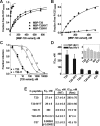Interactions of HIV-1 inhibitory peptide T20 with the gp41 N-HR coiled coil
- PMID: 19073602
- PMCID: PMC2635040
- DOI: 10.1074/jbc.M809269200
Interactions of HIV-1 inhibitory peptide T20 with the gp41 N-HR coiled coil
Abstract
Cellular entry of human immunodeficiency virus type 1 (HIV-1) involves fusion of viral and cellular membranes and is mediated by structural transitions in viral glycoprotein gp41. The antiviral C-peptide T20 targets the gp41 N-terminal heptad repeat region (N-HR), blocking gp41 conformational changes essential for the entry process. To probe the T20 structure-activity relationship, we engineered a molecular mimic of the entire gp41 N-HR coiled coil using the 5-Helix design strategy. T20 bound this artificial protein (denoted 5H-ex) with nanomolar affinity (K(D) = 30 nm), close to its IC50 concentration (approximately 3 nm) but much weaker than the affinity of a related inhibitory C-peptide C37 (K(D) = 0.0007 nm). T20/C37 competitive binding assays confirmed that T20 interacts with the hydrophobic groove on the surface of the N-HR coiled coil outside of a deep pocket region crucial for C37 binding. We used 5H-ex to investigate how the T20 N and C termini contributed to the inhibitor binding activity. Mutating three aromatic residues at the T20 C terminus (WNWF --> ANAA) had no effect on affinity, suggesting that these amino acids do not participate in T20 binding to the gp41 N-HR. The results support recent evidence pointing to a different role for these residues in T20 inhibition (Peisajovich, S. G., Gallo, S. A., Blumenthal, R., and Shai, Y. (2003) J. Biol. Chem. 278, 21012-21017; Liu, S., Jing, W., Cheung, B., Lu, H., Sun, J., Yan, X., Niu, J., Farmar, J., Wu, S., and Jiang, S. (2007) J. Biol. Chem. 282, 9612-9620). By contrast, mutations near the T20 N terminus substantially influenced inhibitor binding strength. When Ile was substituted for Thr in the second T20 position, a 40-fold increase in binding affinity was measured (K(D) = 0.75 nm). The effect of this affinity enhancement on T20 inhibitory potency varied among different viral strains. The original T20 and the higher affinity T20 variant had similar potency against wild type HIV-1. However, the higher affinity T20 variant was significantly more potent against T20-resistant virus. The findings suggest that other factors in addition to binding affinity play a role in limiting T20 potency. As a mimetic of the complete gp41 N-HR coiled coil region, 5H-ex will be a useful tool to further elucidate mechanistic profiles of C-peptide inhibitors.
Figures






Similar articles
-
Creating an Artificial Tail Anchor as a Novel Strategy To Enhance the Potency of Peptide-Based HIV Fusion Inhibitors.J Virol. 2016 Dec 16;91(1):e01445-16. doi: 10.1128/JVI.01445-16. Print 2017 Jan 1. J Virol. 2016. PMID: 27795416 Free PMC article.
-
The Tryptophan-Rich Motif of HIV-1 gp41 Can Interact with the N-Terminal Deep Pocket Site: New Insights into the Structure and Function of gp41 and Its Inhibitors.J Virol. 2019 Dec 12;94(1):e01358-19. doi: 10.1128/JVI.01358-19. Print 2019 Dec 12. J Virol. 2019. PMID: 31619552 Free PMC article.
-
The C4 region as a target for HIV entry inhibitors--NMR mapping of the interacting segments of T20 and gp120.FEBS J. 2015 Dec;282(24):4643-57. doi: 10.1111/febs.13541. Epub 2015 Oct 22. FEBS J. 2015. PMID: 26432362 Free PMC article.
-
Biochemistry and biophysics of HIV-1 gp41 - membrane interactions and implications for HIV-1 envelope protein mediated viral-cell fusion and fusion inhibitor design.Curr Top Med Chem. 2011 Dec;11(24):2959-84. doi: 10.2174/156802611798808497. Curr Top Med Chem. 2011. PMID: 22044229 Free PMC article. Review.
-
Peptide and non-peptide HIV fusion inhibitors.Curr Pharm Des. 2002;8(8):563-80. doi: 10.2174/1381612024607180. Curr Pharm Des. 2002. PMID: 11945159 Review.
Cited by
-
Highly potent chimeric inhibitors targeting two steps of HIV cell entry.J Biol Chem. 2011 Aug 12;286(32):28370-81. doi: 10.1074/jbc.M111.234799. Epub 2011 Jun 9. J Biol Chem. 2011. PMID: 21659523 Free PMC article.
-
Optimization of peptidic HIV-1 fusion inhibitor T20 by phage display.Protein Sci. 2019 Aug;28(8):1501-1512. doi: 10.1002/pro.3669. Protein Sci. 2019. PMID: 31228294 Free PMC article.
-
Complex interplay of kinetic factors governs the synergistic properties of HIV-1 entry inhibitors.J Biol Chem. 2017 Oct 6;292(40):16498-16510. doi: 10.1074/jbc.M117.791731. Epub 2017 Jul 10. J Biol Chem. 2017. PMID: 28696261 Free PMC article.
-
Site-Specific Polymer Attachment to HR2 Peptide Fusion Inhibitors against HIV-1 Decreases Binding Association Rates and Dissociation Rates Rather Than Binding Affinity.Bioconjug Chem. 2017 Mar 15;28(3):701-712. doi: 10.1021/acs.bioconjchem.6b00540. Epub 2016 Oct 27. Bioconjug Chem. 2017. PMID: 27737540 Free PMC article.
-
Potent anti-HIV-1 activity of N-HR-derived peptides including a deep pocket-forming region without antagonistic effects on T-20.Antivir Chem Chemother. 2011 Aug 23;22(1):51-5. doi: 10.3851/IMP1836. Antivir Chem Chemother. 2011. PMID: 21860071 Free PMC article.
References
-
- Peisajovich, S. G., Gallo, S. A., Blumenthal, R., and Shai, Y. (2003) J. Biol. Chem. 278 21012-21017 - PubMed
-
- Liu, S., Jing, W., Cheung, B., Lu, H., Sun, J., Yan, X., Niu, J., Farmar, J., Wu, S., and Jiang, S. (2007) J. Biol. Chem. 282 9612-9620 - PubMed
-
- Fenouillet, E., and Jones, I. M. (1995) J. Gen. Virol. 76 1509-1514 - PubMed
Publication types
MeSH terms
Substances
Grants and funding
LinkOut - more resources
Full Text Sources
Other Literature Sources
Research Materials
Miscellaneous

